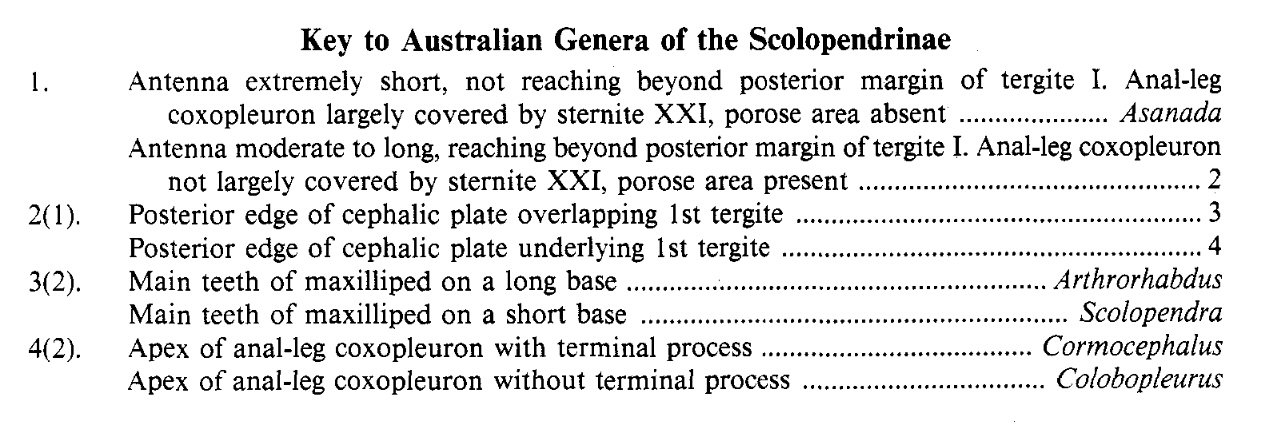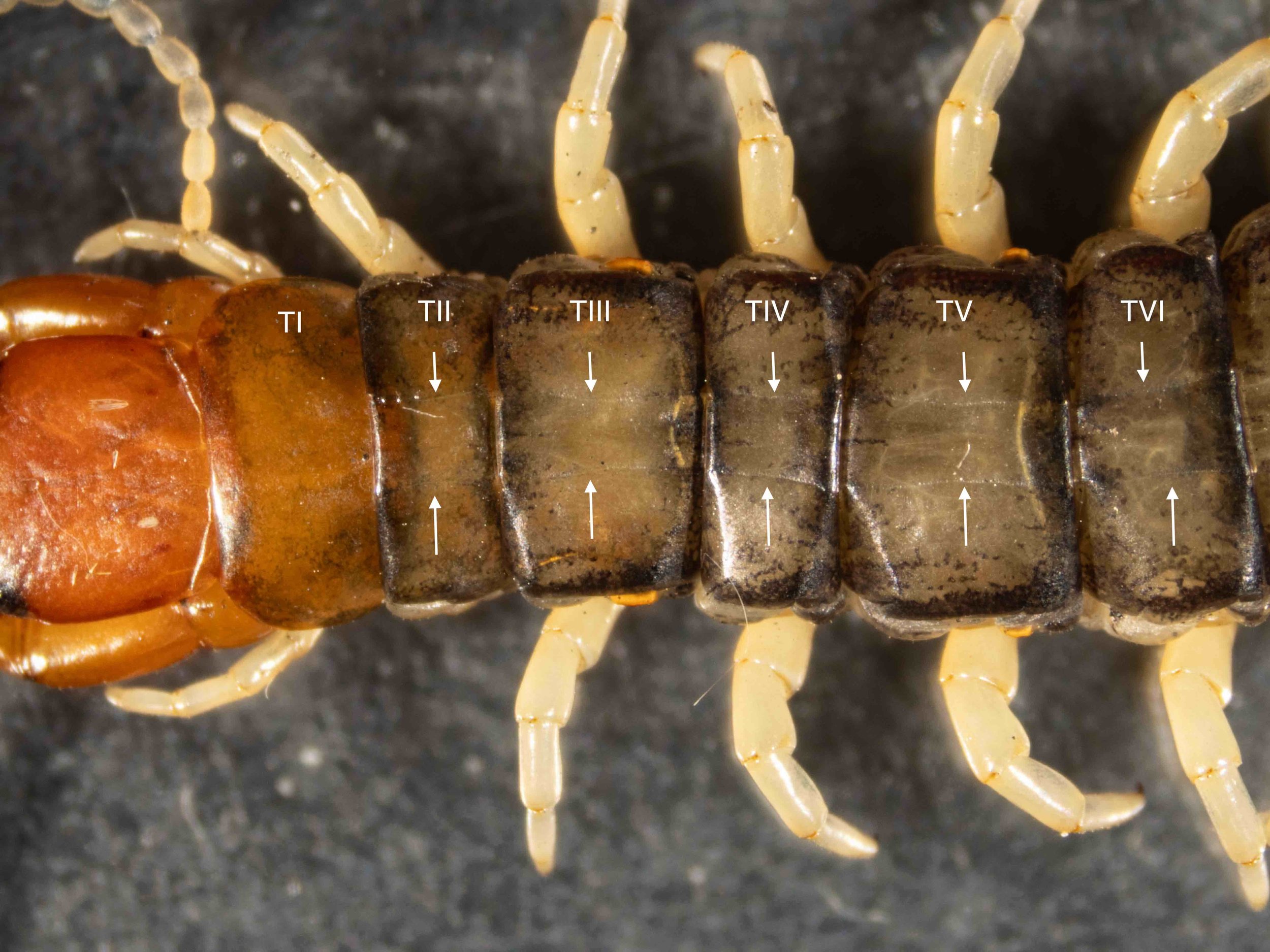Cormocephalus westwoodi (Chilopoda:Scolopendridae:Scolopendrinae)

Workbook
We occasionally see a large, distinctive centipede, often under or in logs on the forest floor. On this page I explain how I identified this centipede as the species Cormocephalus westwoodi.
Notes for identification to species level of a centipede found in a fallen Allocasuarina littoralis tree trunk on 10 November 2024. It was a mature female as it was carrying a clutch of eggs beneath her body - in the usual scolopendromorph fashion.
Literature cited:
Koch, L.E. (1982) “Taxonomy of the centipede Scolopendra laeta Haase (Chilopoda: Scolopendrinae) in Australia” Zool. J. Linn. Soc. 76: 125-140
Koch, L.E. (1983a) “Morphological Characters of Australian Scolopendrid Centipedes, and the Taxonomy and Distribution of Scolopendra morsitans L. (Chilopoda:Scolopendrididae:Scolopendrinae)” Aust. J. Zool. 31: 79-91
Koch, L.E. (1983b) “Revision of the Australian Centipedes of the Genus Cormocephalus Newport (Chilopoda:Scolopendridae:Scolopendrinae)” Aust. J. Zool. 31: 799-833
Which subfamily of Scolopendridae?
Images Figs. 1-4 lead to subfamily Scolopendrinae.
Note that the key states “often overlapping tergite I”, apparently leaving open the possibility that this is not always the case. Indeed Koch (1983) points out that Lawrence (1955) says that the cephalic plate is ‘overlying the first tergite posteriorly or overlapped by it, or both meeting freely, with or without basal plates’. In my animal, the cephalic plate only just overlaps tergite 1 (fig. 1).
However the other characters - the shape of the spiracular opening (fig. 2) and the absence of bristles on proximal tarsal segment (figs. 3, 4) clearly lead to Scolopendrinae.
from Koch (1983a)
Which genus of Scolopendrinae?
Features visible in images lead to step 2 in key. This again asks whether the posterior edge of the cephalic plate overlaps or lies under tergite I.
Given that the uncertainty surrounding this feature, I explored the paths leading to both couplets 3 and 4.
Couplet 3 leads to Arthrorhabdus or Scolopendra.
I excluded Arthrorhabdus based on the 0.8mm length of the base of the main teeth of the maxilliped (figs. 5, 6(. The base of my specimen is ~0.3mm long.
The two Australian species of Scolopendra, S. morsitans and S. laeta show a number of differences to my animal:
body length is 71mm, which places it between the ranges for S. morsitans (85-127mm) and S. laeta (31-65mm).
there are 16 antennal segments (figs. 7, 11), which does not match either species (S. morsitans 20-21, S. laeta 17-19)
there are 2-3 closely set mesal main teeth, separated from 1 lateral tooth (fig. 5) on maxillipeds: S. morsitans has 3-6 main teeth on each side (mostly 5: viz. 3 fused mesal teeth separated from 2, rarely 3, separated lateral teeth); S. laeta has 4 main teeth on each side.
the spine formula of the anal-leg trochanter: A2, B2, C2, D2, E2 (figs. 13-15) does not match either S. laeta A2, B2 or 3, C2-5, D2-4 (mostly 3), E2-5 (mostly 2 or 3) or S. morsitans A2-6 (mostly 2 or 3), B2-6 (mostly 2-4, rarely 6), C2-8 (rarely 2, 7 or 8), D2-6 (mostly 3-4), E2-6 (mostly 3-4, sometimes 5, rarely 6).
there are only 2 spines on anal-leg coxopleural process (fig. 9), whereas S. morsitans NSW has an avg. 4.5; S. laeta avg. 3.1
As the genera in couplet 3 do not match my animal, I considered the genera in couplet 4 - Cormocephalus and Colobopleurus.
Colobopleurus was excluded because the apex of the anal-leg coxopleuron in that genus does not have a terminal process, which is present in my specimen and Cormocephalus (fig. 9).
Which species of Cormocephalus?
I used the key in Koch (1983) to find a species matching my centipede.
Couplet 1. Tergite 1 does not have a pair of complete median sulci (fig. 11)
Couplet 4. Anal-leg trochanter has a spine-row A with 2 large spines (fig. 14)
Couplet 5. Anal-leg trochanter has a spine-row E (fig. 13)
Couplet 11. Anal-leg coxopleuron has porose area practically reaching posterior edge (fig. 9)
Couplet 12. Pair of median sulci complete starting from tergite II (figs. 11, 12)
Couplet 14. Anal-leg trochanter spine row has spine-row E with 2 spines (fig. 13)
Couplet 16. Anal-leg coxopleural porose area very wide: median ridge absent (fig. 9)
This leads to C. monteithi. However, it is clear from the full description of this species that it does not match my specimen.
I therefore considered the description of the other option in that couplet - C. westwoodi. As detailed below, this species matches my specimen very well.
Description of Cormocephalus westwoodi
Observations from Koch (1983) in italics, mine in bold.
Diagnosis: A large to very large species without transverse grooves on maxilliped base-plates and with median sulcus of tergite XXI present. Distinguishable from sympatric C. brachycerus by presence of spine row E on anal-leg trochanter.
Measurements:
Head plus body length 51-105mm mean 70 – 71mm
Cephalic plate width 3.0-5.2 mean 4.2 – 2.8mm
Anal-leg trochanter length 2.5-4.6mm mean 3.7 – 2.8mm
Antennae short to moderately long, first 6-8 segments glabrous – Antennae reaching to rear of tergite III (moderately long on Koch’s definition), first 8 segments glabrous (figs. 7, 11)
Colour:
Most tergites dull greenish yellow-brown – agreed with a dark transverse band at posterior margin and also at the anterior margin in more anterior tergites(fig. 10)
Tergite XXI yellow-brown to orange-brown – Tergite XXI orange (fig. 10)
Cephalic plate, toxignaths and head ventrally orange – agreed (fig. 5)
Antennae with basal segments dull greenish and terminal (sometimes all) segments pale yellow – bluish green with distal and some middle segments pale yellow (fig. 11)
Legs cream to yellow-brown to orange-brown – pale yellow with greenish tinge on tarsi (figs. 10, 12)
Head morphology:
Maxilliped base-plates not wrinkled, transverse grooves absent - agreed (fig. 5)
Median sulcus extending posteriorly from junction of teeth-bases, short, weak - agreed (fig. 5)
Main teeth on each side 4, viz. 1 lateral tooth and 2 or all 3 mesal teeth closely set, teeth-base short - 1 lateral tooth and 3 mesal teeth closely set, teeth-base short (fig. 5)
Tooth-process on trochanter of maxilliped with 1 large tooth or no clearly defined teeth on its mesal edge apically - 1 large tooth on its mesal edge apically (fig. 5)
Trunk morphology:
Pair of median sulci complete starting from tergite II - agreed (figs. 10-12)
Lateral margins starting from tergites VII-XIII, mostly IX-XI - starting from tergite VI (figs. 10, 12)
Tergite XXI wider than long - agreed (fig. 10); posterior edge weakly to strongly convex - strongly convex (fig. 10); median sulcus present - agreed (fig. 10)
Sternite XXI narrowing moderately - agreed (fig. 9); middle part of lateral edges practically straight middle part of posterior edge straight - agreed (fig. 9); median depression sometimes present, wide - not present (fig. 9)
Leg morphology:
2 bristles at base of claw mostly absent, where present short, sometimes minute, absent in anal-legs - not present (figs. 3, 4, 9)
Anal-leg claw c. 3/4 length of to longer than distal tarsus - c. 2/3 length (fig. 8, 10)
Other legs with claw from c. 1/2 length to about same length as distal tarsus - c. 1/2 length (figs. 3, 4, 9)
Anal-leg coxopleuron moderately long, narrow to moderately wide - moderately long, moderately wide (fig. 8)
Porose area extending on each side of often long, sometimes very small median space, reaching posterior edge or sometimes near it - covers almost all of coxopleuron, leaving only distal region of process without pores (fig. 9)
Apex spines usually 2, rarely 3 or 4, small to large, slightly curved - 2 small straight apex spines (fig. 9)
Spine formula of anal-legs: A2; B, 1-5 (rarely 3-5); C 2-5 (rarely 4 or 5); D, 2 or 3 (rarely 3); E, 1-2 (rarely 1); rows D and E close together - formula A2; B2; C2; D2; E2; rows D and E close together (figs. 13-15)
Distribution: southern and north-eastern Victoria, Tasmania, eastern coastal and near-coastal New South Wales, the Australian Capital Territory, and north-eastern coastal and north-central coastal Queensland.
Summary: My specimen is a close match to the description of C. westwoodi
This is a workbook page … a part of our website where we record the observations and references used in making species identifications. The notes will not necessarily be complete. They are a record for our own use, but we are happy to share this information with others.


















